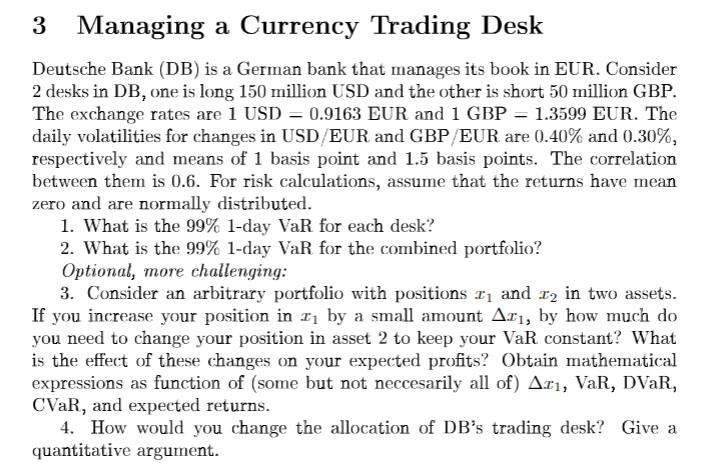
3 Managing a Currency Trading Desk Deutsche Bank (DB) is a German bank that manages its book in EUR. Consider 2 desks in DB, one is long 150 million USD and the other is short 50 million GBP. The exchange rates are 1 USD = 0.9163 EUR and 1 GBP = 1.3599 EUR. The daily volatilities for changes in USD EUR and GBP EUR are 0.40% and 0.30%, respectively and means of 1 basis point and 1.5 basis points. The correlation between them is 0.6. For risk calculations, assume that the returns have mean zero and are normally distributed. 1. What is the 99% 1-day VaR for each desk? 2. What is the 99% 1-day VaR for the combined portfolio? Optional, more challenging: 3. Consider an arbitrary portfolio with positions 11 and 12 in two assets. If you increase your position in I by a small amount A11, by how much do you need to change your position in asset 2 to keep your VaR constant? What is the effect of these changes on your expected profits? Obtain mathematical expressions as function of (some but not neccesarily all of) Ari, VaR, DVAR, CVR, and expected returns. 4. How would you change the allocation of DB's trading desk? Give a quantitative argument. 3 Managing a Currency Trading Desk Deutsche Bank (DB) is a German bank that manages its book in EUR. Consider 2 desks in DB, one is long 150 million USD and the other is short 50 million GBP. The exchange rates are 1 USD = 0.9163 EUR and 1 GBP = 1.3599 EUR. The daily volatilities for changes in USD EUR and GBP EUR are 0.40% and 0.30%, respectively and means of 1 basis point and 1.5 basis points. The correlation between them is 0.6. For risk calculations, assume that the returns have mean zero and are normally distributed. 1. What is the 99% 1-day VaR for each desk? 2. What is the 99% 1-day VaR for the combined portfolio? Optional, more challenging: 3. Consider an arbitrary portfolio with positions 11 and 12 in two assets. If you increase your position in I by a small amount A11, by how much do you need to change your position in asset 2 to keep your VaR constant? What is the effect of these changes on your expected profits? Obtain mathematical expressions as function of (some but not neccesarily all of) Ari, VaR, DVAR, CVR, and expected returns. 4. How would you change the allocation of DB's trading desk? Give a quantitative argument







